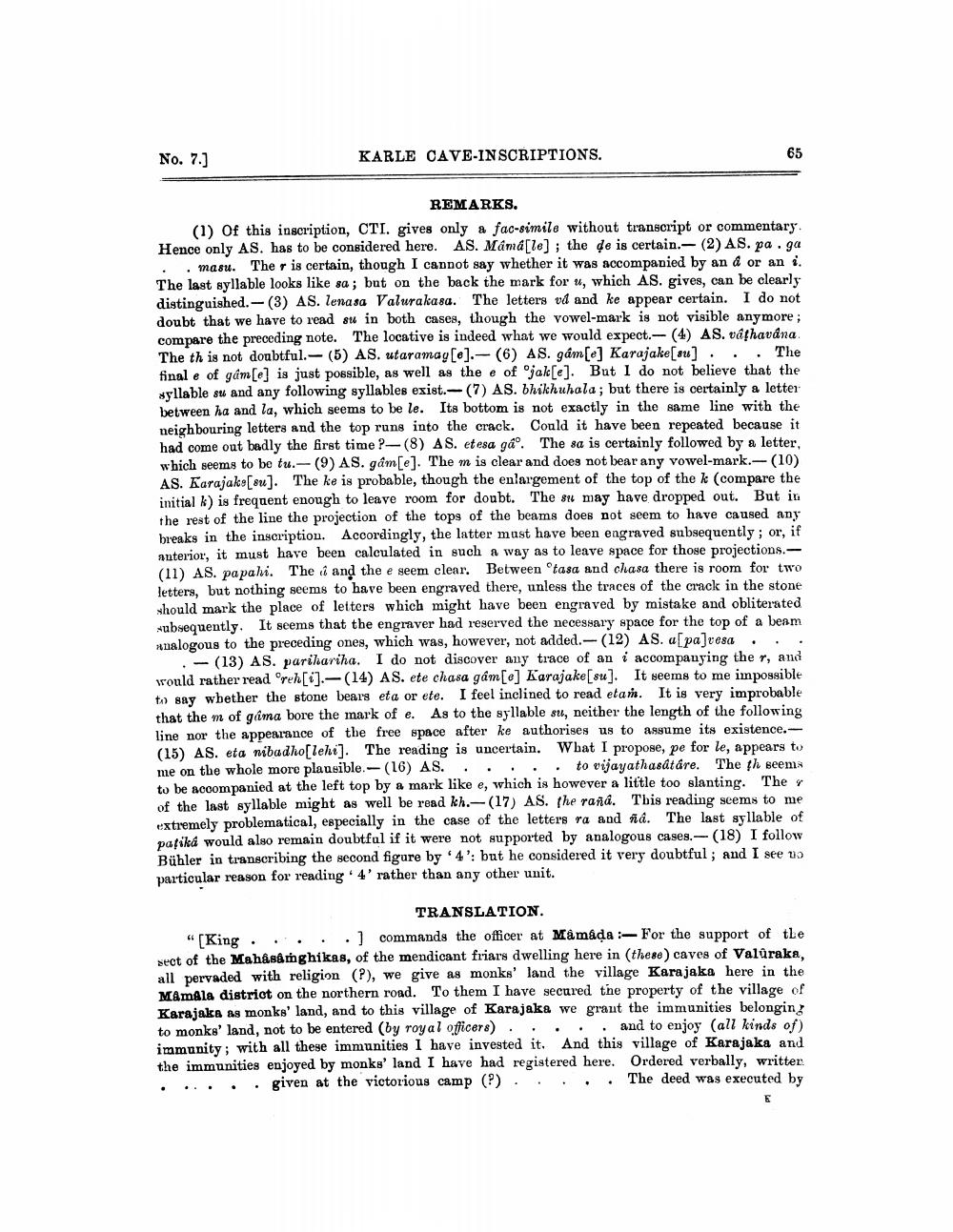________________
No. 7.]
KARLE CAVE-INSCRIPTIONS.
65
REMARKS.
(1) Of this inscription, CTI. gives only a fac-simile without transcript or commentary. Hence only AS. has to be considered here. AS. Mámá[le]; the de is certain.- (2) AS. pa. ga . masu. The r is certain, though I cannot say whether it was accompanied by an & or an i. The last syllable looks like sa; but on the back the mark for u, which AS. gives, can be clearly distinguished. (3) AS. lenasa Valurakasa. The letters vd and ke appear certain. I do not doubt that we have to read su in both cases, though the vowel-mark is not visible anymore; compare the preceding note. The locative is indeed what we would expect.- (4) AS. vathavana. The th is not doubtful.- (5) AS. utaramag [e].- (6) AS. gám[e] Karajake [su]. The final e of gam[e] is just possible, as well as the e of jak[e]. But I do not believe that the syllable su and any following syllables exist.- (7) AS. bhikhuhala; but there is certainly a letter between ha and la, which seems to be le. Its bottom is not exactly in the same line with the neighbouring letters and the top runs into the crack. Could it have been repeated because it had come out badly the first time ?-(8) AS. etesa ga. The sa is certainly followed by a letter, which seems to be tu.-(9) AS. gâm[e]. The m is clear and does not bear any vowel-mark.- (10) AS. Karajake[su]. The ke is probable, though the enlargement of the top of the k (compare the initial k) is frequent enough to leave room for doubt. The su may have dropped out. But in the rest of the line the projection of the tops of the beams does not seem to have caused any breaks in the inscription. Accordingly, the latter must have been engraved subsequently; or, if anterior, it must have been calculated in such a way as to leave space for those projections.(11) AS. papahi. The & and the e seem clear. Between tasa and chasa there is room for two letters, but nothing seems to have been engraved there, unless the traces of the crack in the stone should mark the place of letters which might have been engraved by mistake and obliterated subsequently. It seems that the engraver had reserved the necessary space for the top of a beam analogous to the preceding ones, which was, however, not added.-(12) AS. a[pa]vesa.
(13) AS. parihariha. I do not discover any trace of an accompanying the r, and would rather read reh[i].-(14) AS. ete chasa gám[e] Karajake[su]. It seems to me impossible to say whether the stone bears eta or ete. I feel inclined to read etam. It is very improbable that the m of gama bore the mark of e. As to the syllable su, neither the length of the following line nor the appearance of the free space after ke authorises us to assume its existence.(15) AS. eta nibadho[lehi]. The reading is uncertain. What I propose, pe for le, appears to me on the whole more plausible.- (16) AS. .. to vijayathasâtáre. The th seems to be accompanied at the left top by a mark like e, which is however a little too slanting. The of the last syllable might as well be read kh.-(17) AS. the raña. This reading seems to me extremely problematical, especially in the case of the letters ra and ñd. The last syllable of patiká would also remain doubtful if it were not supported by analogous cases.- -(18) I follow Bühler in transcribing the second figure by 4': but he considered it very doubtful; and I see no particular reason for reading 4' rather than any other unit.
TRANSLATION.
"[King. ] commands the officer at Mâmâda:- For the support of the sect of the Mahasamghikas, of the mendicant friars dwelling here in (these) caves of Valûraka, all pervaded with religion (?), we give as monks' land the village Karajaka here in the Mamala district on the northern road. To them I have secured the property of the village of Karajaka as monks' land, and to this village of Karajaka we grant the immunities belonging to monks' land, not to be entered (by royal officers).. and to enjoy (all kinds of) immunity; with all these immunities I have invested it. And this village of Karajaka and the immunities enjoyed by monks' land I have had registered here. Ordered verbally, writter. .. given at the victorious camp (?). .
The deed was executed by
E




